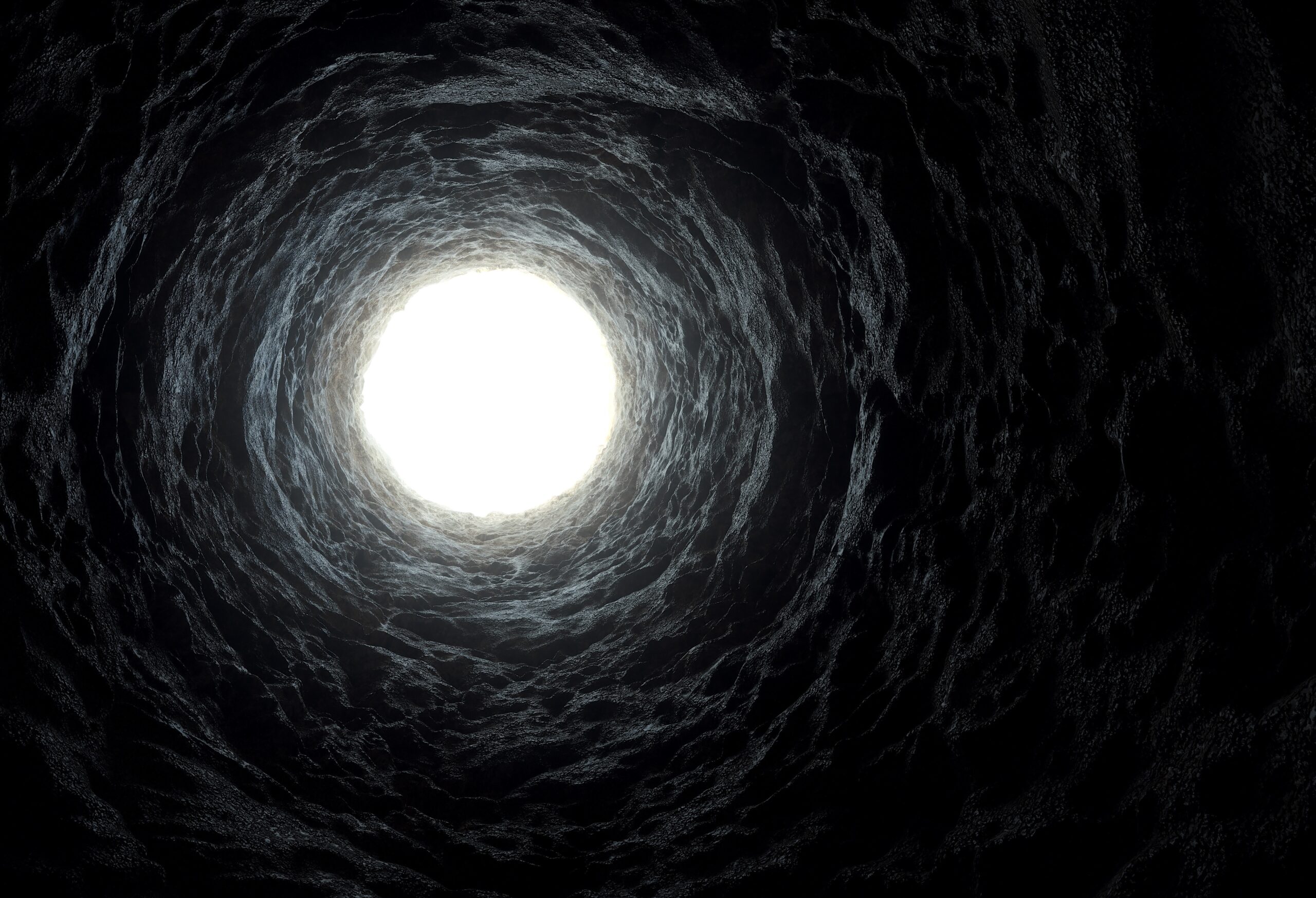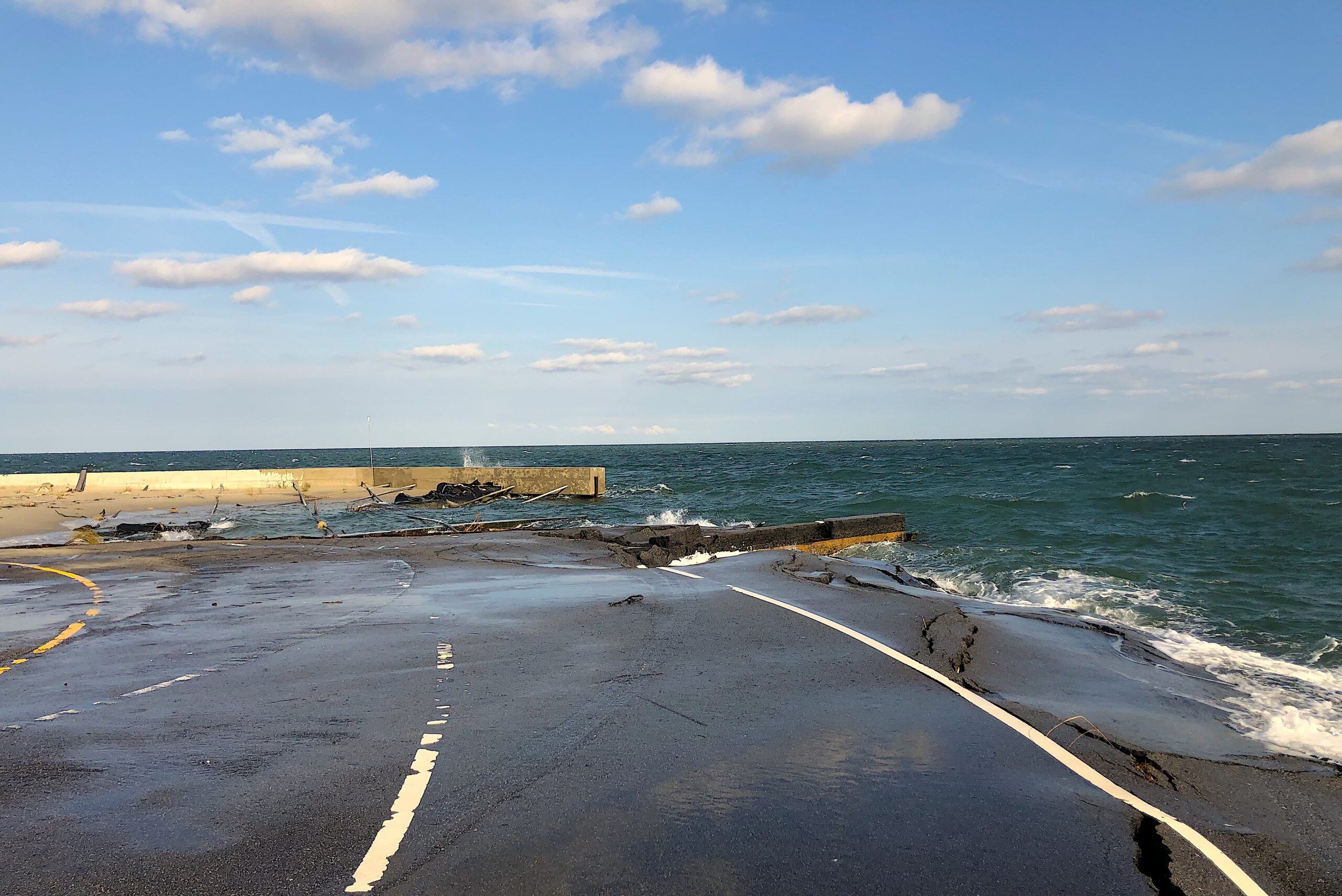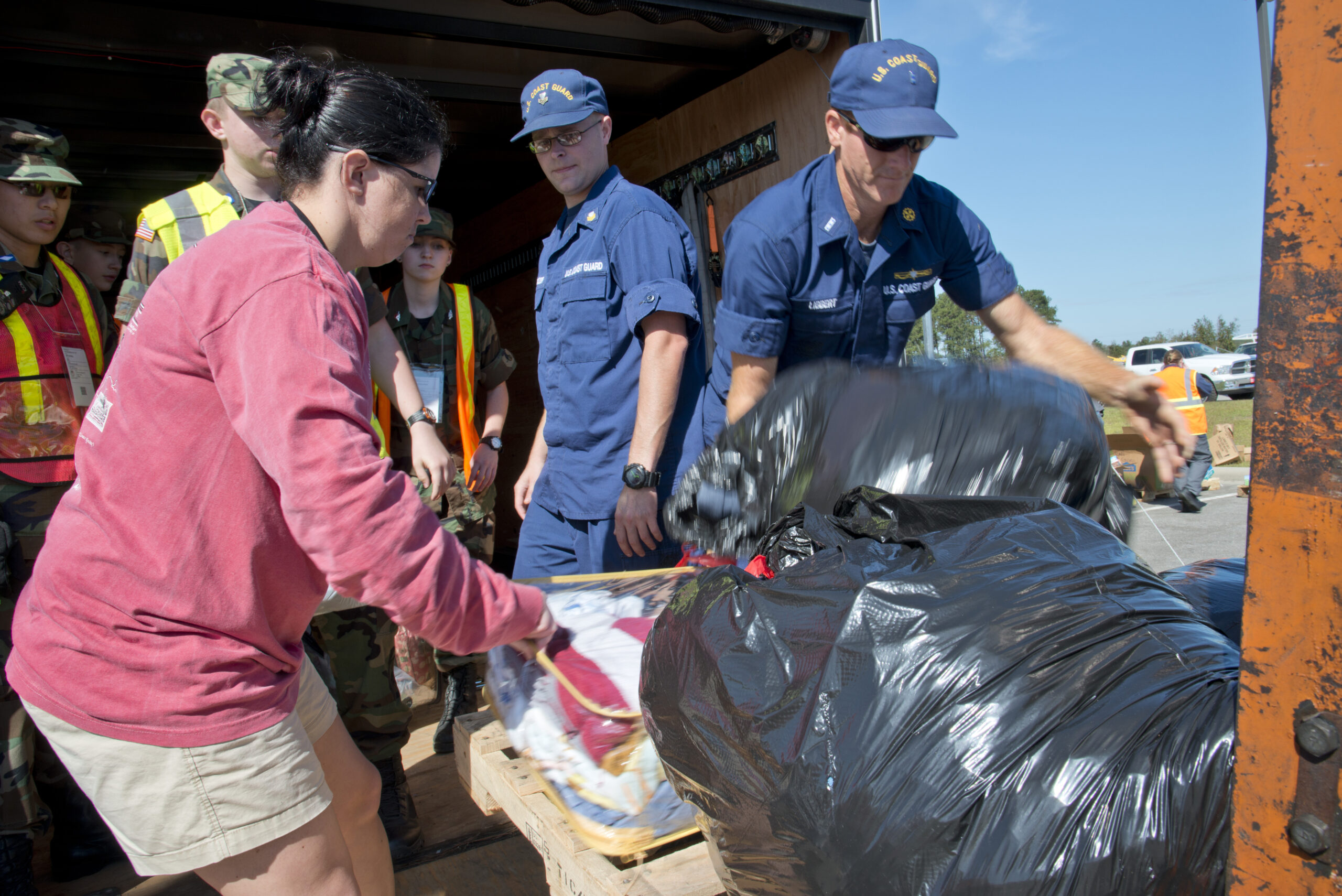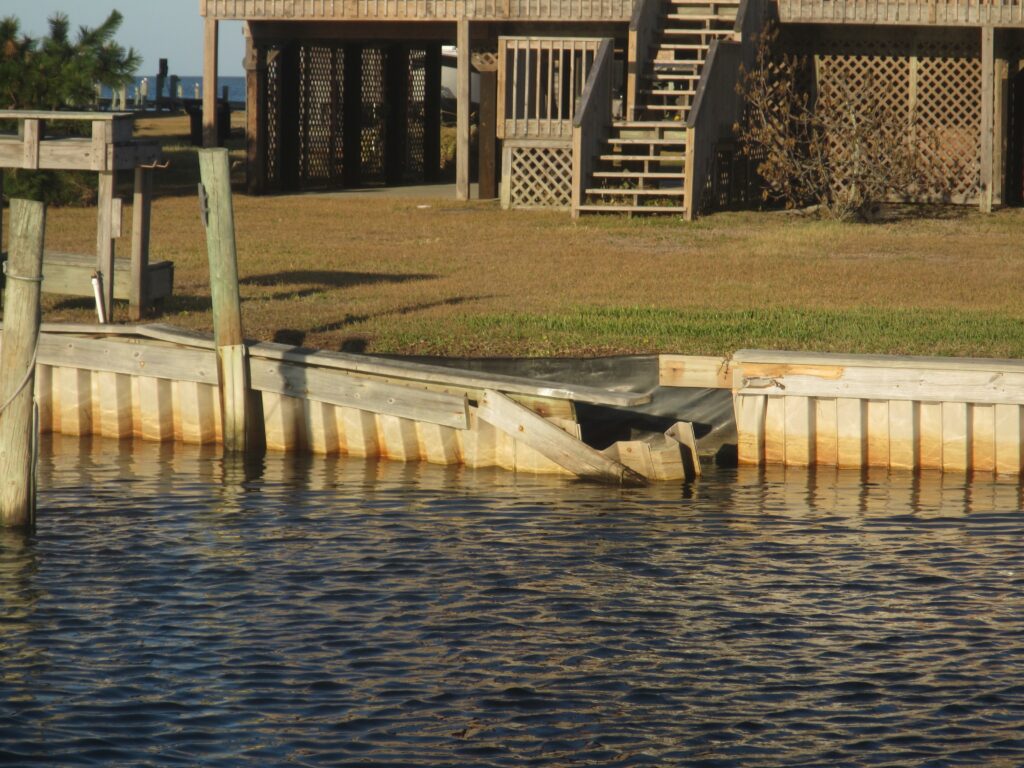
Bulkheads have been popular, but these structures come with a number of negatives.
Bulkheads are vertical retaining walls designed to hold land in place by creating a distinct separation between land and water. Bulkheads, seawalls, and revetments are similar hard structures, also known as “gray,” “armored,” or “hardened” shorelines.
In North Carolina, bulkheads typically are composed of concrete, steel, wood, or vinyl. Generally, installation involves piledriving or pressure-jetting a pillar into the sediment and placing a vertical wall behind it. The vertical wall often has a lining of filter cloth with buried anchors. The landward side of the wall is then filled with sand and usually landscaped with lawn grasses that may not be eco-friendly.
Bulkheads can withstand the impacts from mild, low-energy waves but become progressively weaker over time, especially in moderate and high-energy areas.
At locations with marinas, narrow canals, deep water, or buildings close to the water’s edge, a bulkhead might be the only option. Some homeowners install bulkheads because they prefer the aesthetics over a natural intertidal look.
Historically, bulkheads have been popular, but today we know that these structures have a number of negative consequences. In many situations there are better and cost-effective options, like living shorelines, that are more suitable and reliable for controlling erosion.
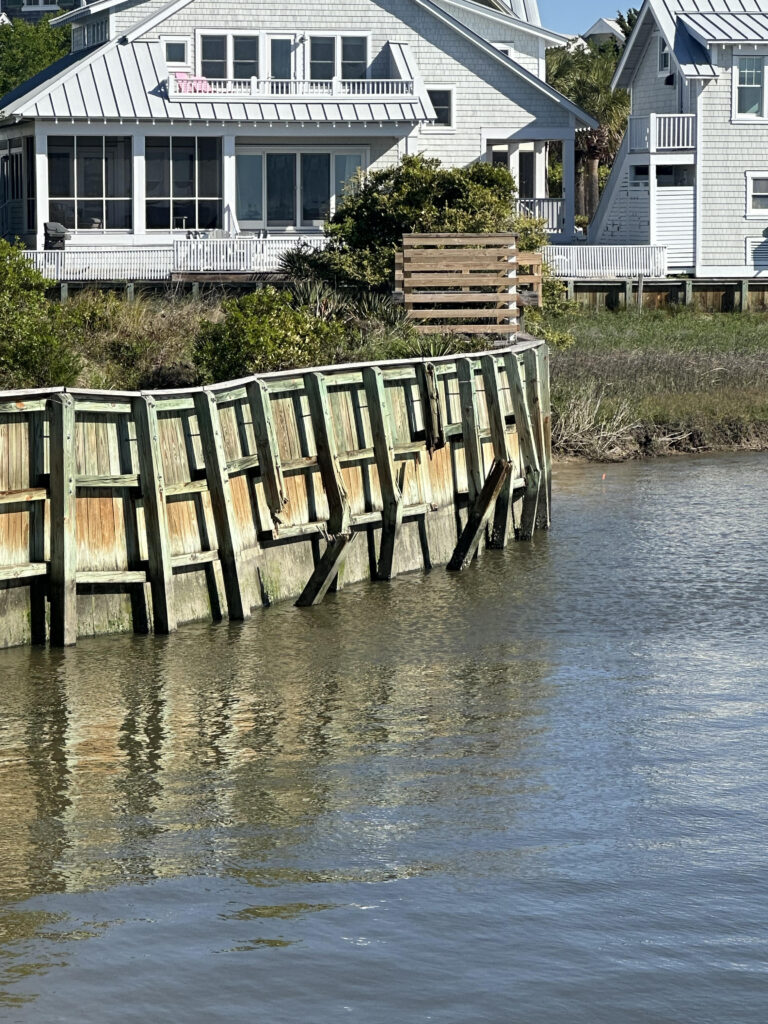
What are the drawbacks of bulkheads?
Costly Maintenance
Compared to other options, bulkheads sometimes are cheaper to install; however, the long-term costs of maintenance can be four times as expensive as other choices.
Increased Damage During Storms
Bulkheads also suffer storm damage at a higher rate than other options. Storm damage often happens when waves overtop the bulkhead and cause scouring. Storm damage can also occur during intense wave energy against the wall of the bulkhead.
Risky Construction
Bulkheads can make areas appear safer than they actually are, which can result in home construction in locations that actually are high-risk. This can lead to unnecessary dangers for residents and property. Coastal residents should stay informed when choosing where to live and know the risks of storm surge and flooding, especially when living close to the water.
Loss of Sediment and Erosion
Bulkheads can cause loss of sediment and erosion when wave energy reflects off them. Wave energy at the ends of bulkheads and in front of them also can scour away sand and bottom habitat. Bulkheads can erode the shorelines next to them as well, negatively affecting neighboring properties.
Loss of Wetlands
By cutting off the connection between land and water, bulkheads result in the loss of valuable wetland habitat that wildlife, fisheries, and economies depend on.
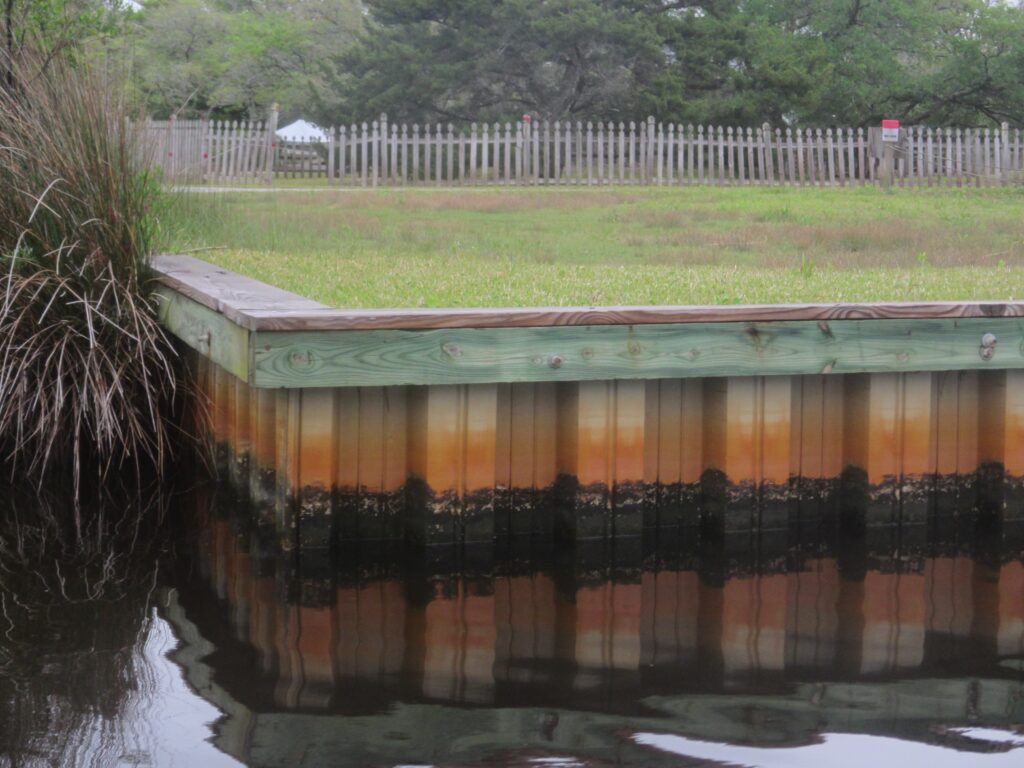
What maintenance tips can extend the life of a bulkhead?
How often a bulkhead is exposed to major storms, harsh wind and wave conditions, and stormwater runoff can influence how long it lasts.
Bulkheads have a life expectancy of about 25 years, depending on their composition and location — and their maintenance. The following practices can extend the life of a bulkhead and/or save money:
Planning for the Future
Be prepared for the future cost of replacing or repairing your bulkhead. When and if your bulkhead needs to be replaced, assess site conditions to see if your shoreline is suitable for a living shoreline instead.
Growing a Shoreline Border
Lawn grasses have shallow roots that do little to reduce erosion. Leaving or adding at least a 5-foot strip of plants running the length of the bulkhead will increase erosion protection. (See p. 12 of the Coastal Landscape Initiative’s NC Coastal Landscaping Designs on shoreline borders.)
Choosing the Right Plants
Select native grasses and perennials have adapted to the soils and climate where you live. Plants hold soil in place and reduce the loss of sediment; if the bulkhead is in brackish or salty water, choose salt-tolerant plants. Avoid planting trees and shrubs with 10 feet of a bulkhead, though, because the roots of some trees and shrubs can damage buried parts of the structure.
Regular Monitoring
Inspect bulkheads seasonally, as well as before and after storms. Take pictures from many angles before and after storm events to catalog changes. Look for:
- divots or holes in the ground near the bulkhead, which can indicate that failure is occurring below ground.
- leaning, bowing, or wobbles in the wall that are new. (You can use a construction level or the digital level on many cell phones to keep an eye on changes.)
- damage to structural components, including severe rusting, missing pieces, or rotting boards that may need replacing.
Adding a Living Shoreline
If there is ample space in front of your bulkhead that low tides leave exposed, adding a living shoreline can reduce the drawbacks of bulkheads. Living shorelines can become stronger over time because they attract oysters and include eco-friendly plants that have adapted to local conditions. As a result, a living shoreline or salt marsh plants in front of a bulkhead reduces the wave energy impacting it and extend its longevity.
More
Watch this interview with Carter Smith, a North Carolina Sea Grant-funded scientist: As sea level rises, should we build sea walls?
NOAA, the NC Division of Coastal Management, and NC Coastal Reserve and Natural Estuarine Research Reserve created a handbook for estuarine property owners on how to protect property from shoreline erosion.
Read how this Chowan River community dealt with a failing bulkhead.: https://coast.noaa.gov/digitalcoast/training/nc-coast.html
Recognizing how bulkheads change the shoreline
Understanding North Carolina’s dynamic shorelines from Stan Riggs, professor, geologist, and expert in North Carolina’s coastal history
See the many ways that North Carolina’s Coast has changed from natural and human influences, including using bulkheads: https://ncseagrant.ncsu.edu/coastwatch/rising/
Landscape planning worksheet, plant guides, and other resources on plants and sustainable landscaping
Soil test kits and native plant gardening advice from NC State County Extension County Centers and the NC State Extension Gardener Handbook, Chapter 12
The Guide to Coastal Living provides information about how to live in a coastal environment.
Mariko Polk, North Carolina Sea Grant’s coastal processes specialist, has a decade of experience in coastal management and shoreline protection. Gloria Putnam, North Carolina Sea Grant’s coastal resources and communities specialist, has over two decades of experience in natural landscapes and green infrastructure.
